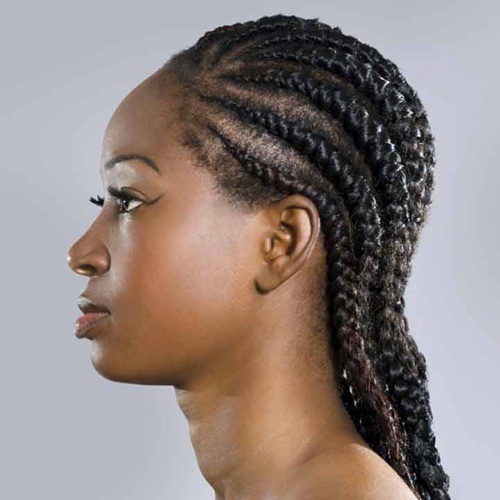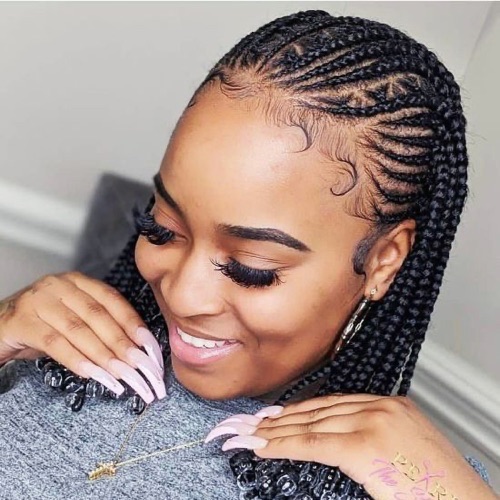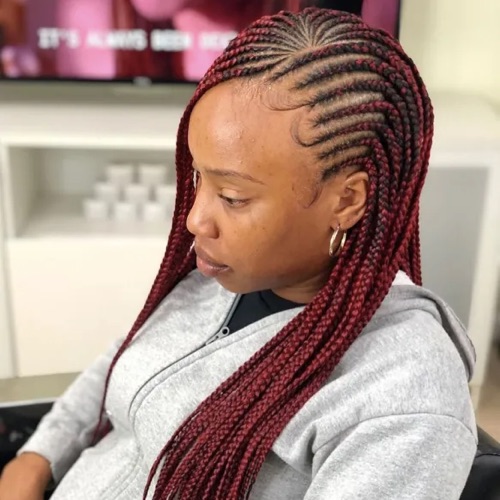The Ndebele are a tribe located in the north of South Africa in the provinces of Limpopo, Mpumalanga and Guateng. For centuries Ndebele traditional attire has been centred around a variety of ornaments such as necklaces, bracelets and rings.
Bright, bold colours along with beautiful beadwork can be found on various clothing items such as ndebele traditional dresses. Read on to learn more about Ndebele traditional attire. Explore dresses below👇🏾
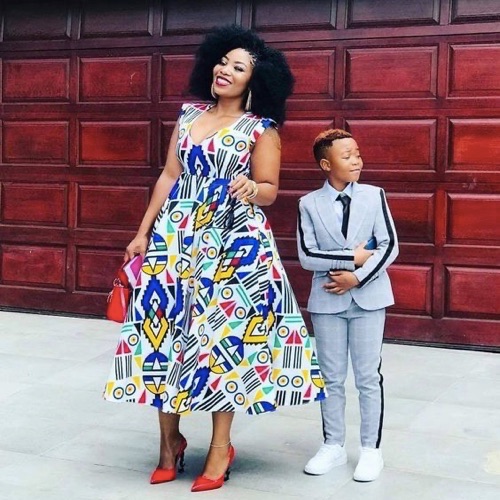
Types of Ndebele Traditional Attire for Ladies
Ndebele women used to adorn themselves with a variety of jewelry, each representing their social position. After marriage, clothing became increasingly complicated and elaborate.
The Ndebele wives wear copper and brass rings on her arms, legs, and neck during earlier times, expressing her loyalty and faithfulness to her husband after she had built her house. She would remove the jewelry only after his passing. Below you find some pictures of classy modern ndebele traditional dresses.
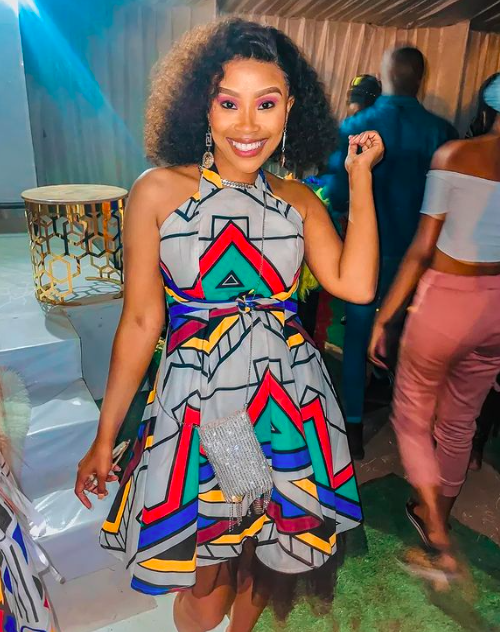
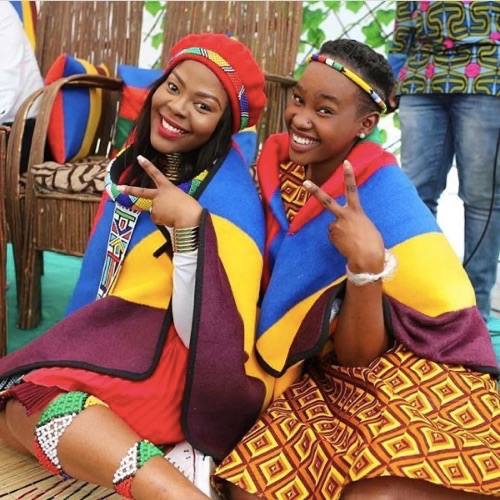
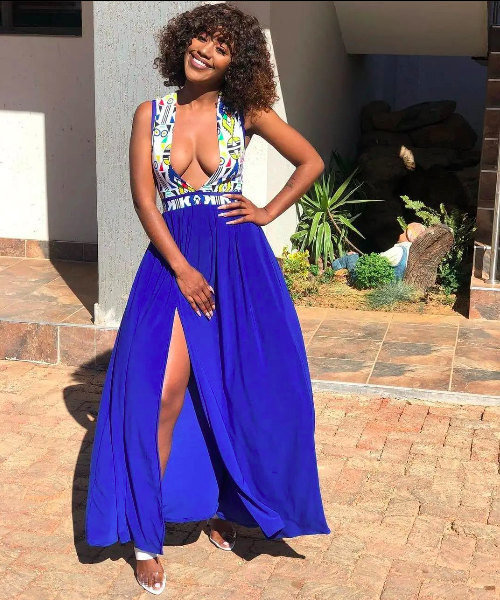
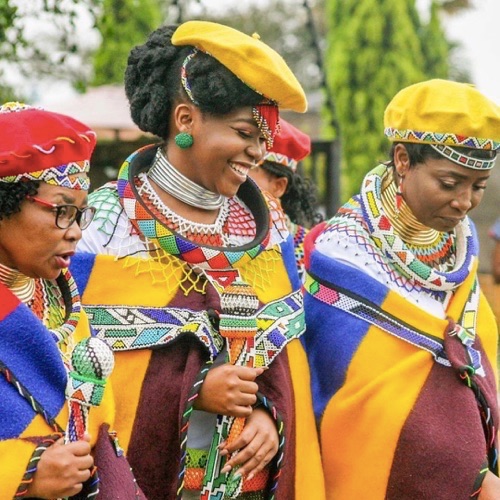
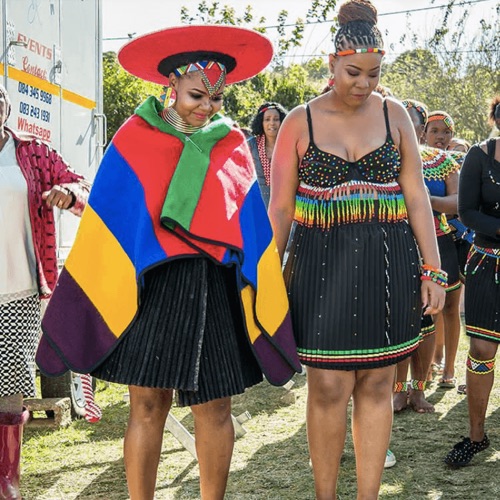
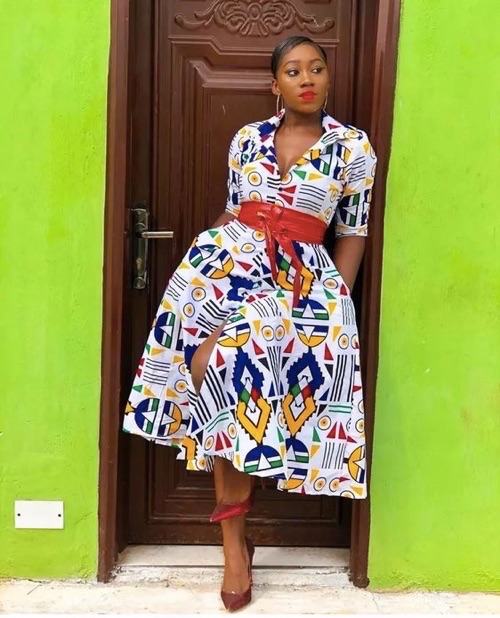
Ndebele Traditional Wedding Dresses
Wives used to receive wedding bands from their husbands; the better off the husband, the more rings he would give his wife. These rings are no longer worn on a daily basis.
Married women also wore grass neck hoops (called isigolwani) twisted into a coil and covered in beads, particularly on special occasions. They also wear an apron called iphotho that is decorated with beads designed in patterns that show her age group, if she is a mother or expecting a child.
Wives wear a blanket called ngurara (if beaded) or ikombesi (if not beaded) over their shoulders. The ngurara were brightly striped with brown, yellow, blue, red, and green. Unmarried girls leave their upper bodies uncovered.
Married women also wore a five-fingered apron (called an ijogolo) to signify the end of their marriage, which only occurs after the birth of the first child. Married women’s marriage blanket (nguba) was embroidered with beads to commemorate significant events in her life. Below you’ll find some pictures of Ndebele wedding dresses.
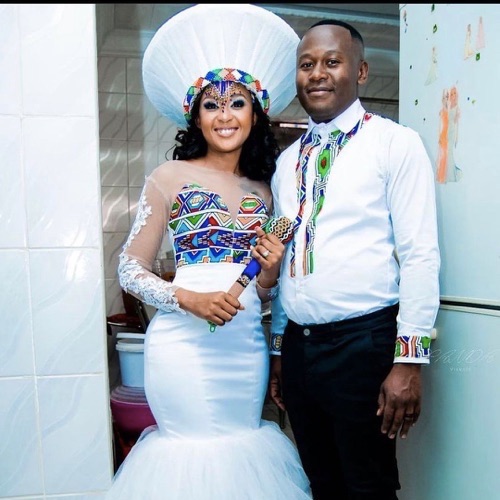
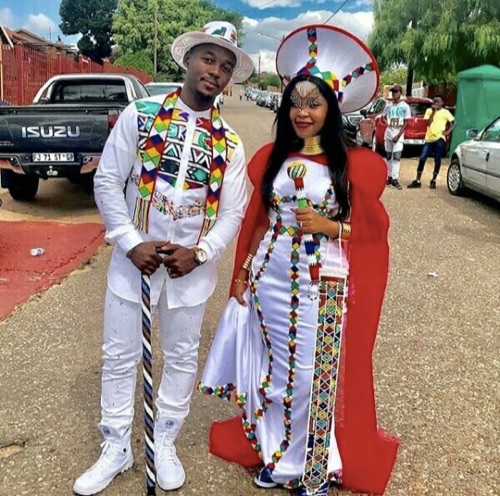
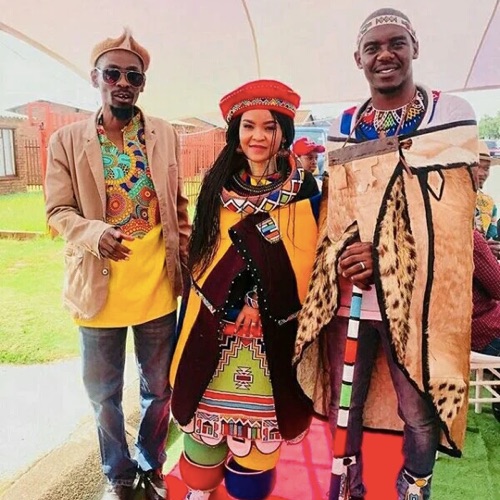
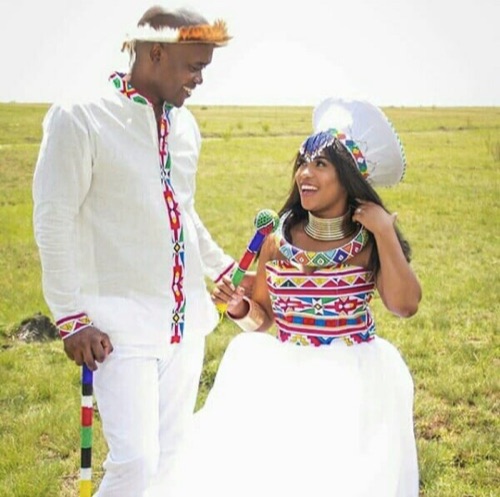
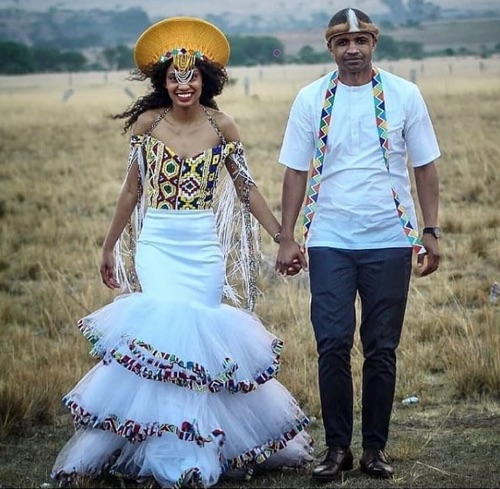
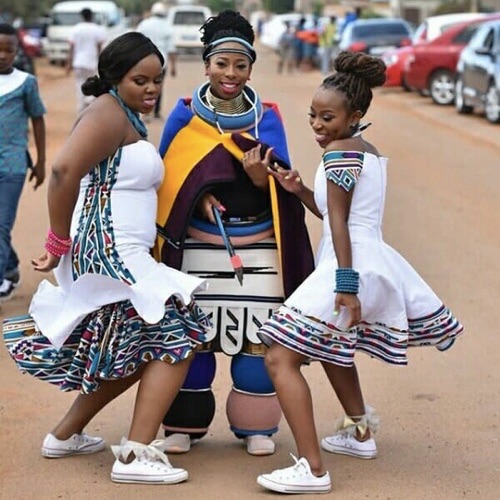
Ndebele Ethnography
Let’s explore the Ndebele ethnography. This involves taking a deep dive into the people, culture and customs of the Ndebele.
Ndebele History
Mafana was the first Ndebele chief whose history is known. Mhlanga, Mafana’s successor had a son named Musi. In the early 1600s, Musi decided to leave his cousins (who later became the Zulu nation) and settle in Gauteng near Pretoria.
Following the death of Chief Musi, his two sons argued about who would succeed him as leader of the tribe. Eventually, the tribe split into two groups: the Manala and the Ndzundza.
The northern Manala remained while the Ndzundza, also known as the Southern Ndebele, traveled east and south. The two groups kept their distinctiveness as Ndebele.
During the reign of Ndebele chieftain Mabhogo in 1883, conflict erupted between the Ndzundza and the (Boer) Zuid-Afrikaansche Republiek. For eight months, the Ndebele hid in subterranean tunnels inside their mountain fortification at Mapoch’s Caves near Roossenaal as they resisted a assault by escaping to subterranean labyrinths.
On occasion, Mabhogo’s daring soldiers were able to cross the enemy lines without being seen in order to get water and food. However, after two female memebrs of the tribe had been ambushed and tortured in the nearby woods, one revealed where Mabhogo was.
After the defeat of Mabhogo, the tribes were dispersed, and their territory was taken from them. Despite the dissolution of the tribe, the Ndebele maintained their cultural cohesion.
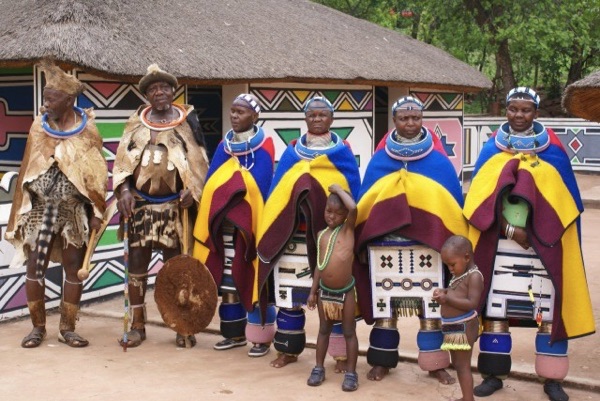
Northern and Southern Ndebele
Ndebele are an Mbo ethnic group located in South Africa who speak the isiNdebele language. The majority of Ndebele people live in the northeast provinces of Mpumalanga, Gauteng and Limpopo.
The South African Ndebele should not be confused with the AbaThwakazi of Zimbabwe, who are a more recent offshoot of the Zulu.
The Southern Ndebele are a subset of the Northern Ndebele, who inhabit large parts of Limpopo and Northwest Provinces. The Northern Ndebele are made up of three major tribes: Gheghana, Mghumbhane, and Mashashani.
The Northern Ndebele and Southern Ndebele are both descendants of Musi kaMhlanga, the same mythical king. The history of the Southern Ndebele with the Pedi people and amakhuwa (Boers) is well-known among them.
Ndebele Art
The Ndebele people have produced many beautiful things, including beautiful art. It has an important cultural significance that serves to strengthen the Ndebele’s distinctiveness. Apart from its aesthetic value, it also has a cultural importance that promotes the distinctive Ndebele identity.
The Ndebele have always been renowned for their art, which skillfully mixes together exterior sources of inspiration with traditional designs from their ancestors.
Ndebele artists were also captured by the linear quality of elements in their environment which is freehandly depicted in their artwork. Although the designs were planned beforehand, painting was done without prior layouts.
Ndebele decorations are characterized by their symmetry, proportion and straight edges. These were all done by hand without the help of any rulers or squares. Ndebele women were responsible for painting the colourful and intricate patterns on the walls of their houses.
House Design
The ability to choose colors and patterns that set her apart from her peer group was new to her. Her originality in the use of hues and designs set her apart from the rest of the class. In some cases, the females created sculpture as a method of self-expression.
Back and side walls were most often times decorated with earth tones and basic geometric shapes that were shaped by fingers then outlined in black. The more creative, complex designs were painted on the front walls of the house, and always in brighter colors.
The entrance (izimpunjwana) was formed by the façade that surrounded the courtyard in front of the house. Windows served as a focal point for mural designs, and their configurations were not always symmetrical.
Sometimes, simple borders painted in a dark color, with white lines, are used to accentuate less significant windows within the courtyard and on the outside walls.
Contemporary Ndebele artists, on the other hand, make more use of various colors (blues, reds, greens, and yellows) than earlier artists were able to due to their commercial availability.
In the past, artists typically used earthy colours like ochre that they created by grinding up different minerals. They also used natural clays in shades of white, brown, pink and yellow. To make black paint, they would burn wood until it turned into charcoal.
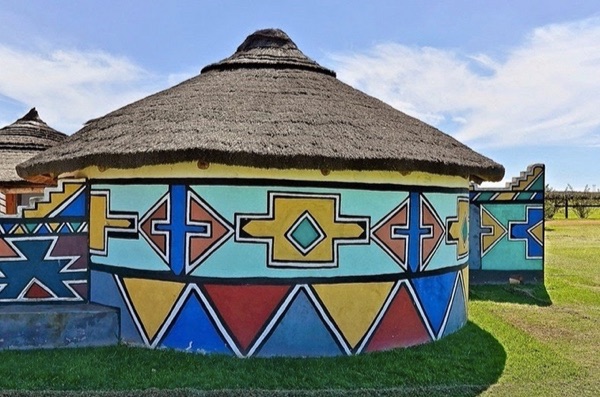
Art in the Modern Day
Today, we are drawn to bright colours. As Ndebele society became more westernised, their paintings started reflecting this change. Another alteration is the addition of stylised representational forms to the usual abstract geometric designs.
In addition to their exterior artwork, many Ndebele artists have now started painting the interiors of houses as well. They also weave other crafts such as sleeping mats and isingolwani.
Grass (colorful neck hoops) is wrapped in cotton and adorned with beads to make the Isingolwani (colorful neck hoops). The hoop is boiled in sugar water for several days to preserve the grass and allow it to maintain its form and hardness.
The Ndebele people are renowned for their beadwork. Beadwork is intricate and time-consuming, necessitating a steady hand and excellent eyesight.
This pastime has long been a social hobby in which women would spend their free time after completing their chores, but these items are now made to sell to the public on many projects.
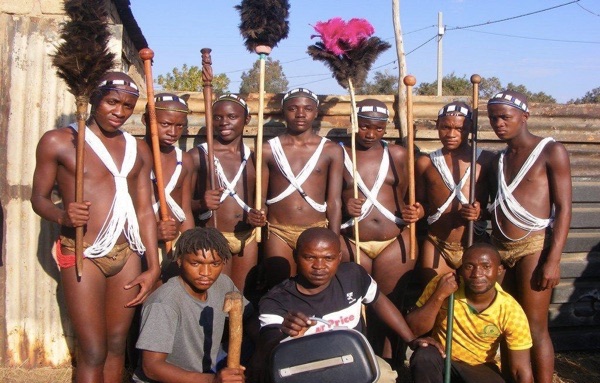
Ndebele Customs
The initiation rite, signifying the transformation from childhood to adulthood, is significant in Ndebele culture. Initiation schools for both genders are held every four years.
When a young person is going through the initiation process, their relatives and friends come from near and far to take part in the related ceremonies and activities.
Boys are initiated into manhood as a group when they turn 18 years old. A special regiment, called an indanga, is set up and led by a boy of high social rank. Each regiment has its own distinguishing name. Among the Ndzundza tribe there is a cycle of 15 such names, allocated successively. The Manala tribe have their own cycle of 13 regimental names
During initiation, young women wear a variety of colorful beaded hoops (called izigolwan) about their legs, arms, waist, and neck. The girls are kept secluded and prepared to become homemakers and matriarchs.
The coming-out ceremony signifies the end of initiation school, and to celebrate, girls wear rectangular aprons (called amaphephetu) that are beaded in three-dimensional patterns. Once initiated, these softer aprons made from leather are replaced with stiffer, square ones that are still adorned with beadwork.

